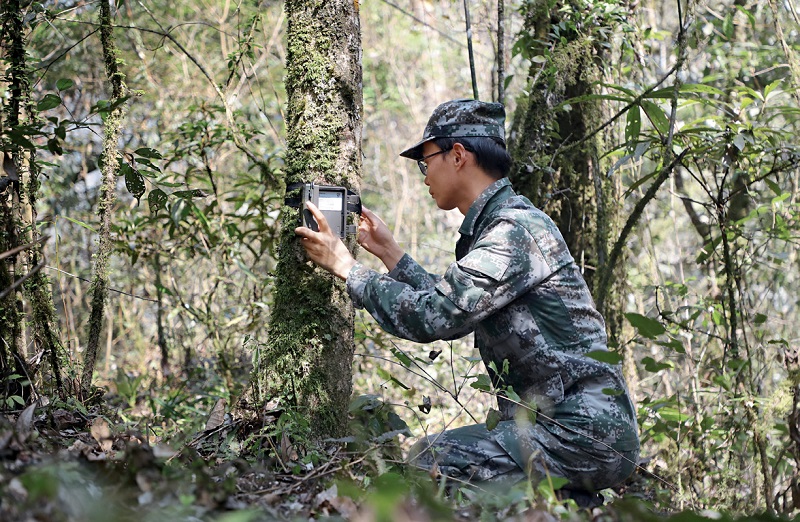
In the dense forest of the Daxiangling Mountains in Sichuan Province grows the favorite food of giant pandas — various bamboo species including arrow bamboo. The slopes are usually covered with snow from the end of November to the end of March the following year. As in the wild, giant pandas generally live at relatively high altitudes and prefer cool environments with rich food resources, rugged terrain, and abundant water, making the mountain range an ideal habitat for them.
The Daxiangling Mountains are part of the Giant Panda National Park, which spans Sichuan, Shaanxi, and Gansu provinces. In the mountain range is nestled the Sichuan Daxiangling Giant Panda Wild Training and Releasing Base, the largest of its kind in the world. The base sits in the Maocaohe and Sanchahe area of the Giant Panda National Park in Yingjing County of Ya’an City in Sichuan.
The mission of the training base is to prepare captive-bred giant pandas for life in the wild. “After the population of giant pandas in captivity has grown to a certain size, some will be released into the wild to expand the wild giant panda population,” Li Desheng, deputy director and lead expert of the China Conservation and Research Center for the Giant Panda (CCRCGP), said.
The Call of the Wild
The giant panda, an aminal species found only in China, has been valued as a national treasure and put under the highest level of state protection. The fourth giant panda population census released in 2015 showed its population in the wild surpassed 1,800. In 2021, the Chinese government announced the downgrading of its conservation status from “endangered” to “vulnerable.” This is a result of intensive efforts to save the rare animal species from extinction. The release of captive giant pandas into the wild, launched in China in 2003, is one of numerous conservation programmes.
China has been breeding giant pandas artificially and raising them in captivity. “Artificial breeding is only one stage and part of the giant panda conservation plan — the ultimate goal is to reintroduce them into the wild to expand the animal’s wild populations,” Li said.
Over the past two decades, the CCRCGP has released 11 giant pandas back into the wild, nine of which have survived. They have strengthened two endangered small populations in the wild, one of which is located in the Liziping National Nature Reserve in Shimian County of Ya’an City, and the other in Longxi-Hongkou National Nature Reserve near Dujiangyan of Sichuan Province. Monitoring shows that they are doing well in the wild and have integrated into the wild population.
Before being released, captive giant pandas must receive wild survival training. “It is necessary for captive giant pandas to master the skills for survival in the wild, such as foraging for food, searching for water, getting along with fellow animals, strengthening territorial awareness, and avoiding risks,” Li said.

An aerial view of the Daxiangling Nature Reserve in Yingjing County of Ya’an City, Sichuan Province.
Panda Monitoring
Song Xinqiang, 35, and Fu Mingxia, 33, are wildlife conservation experts at the Daxiangling Nature Reserve in Yingjing County of Ya’an City.
They both have rich experience in monitoring giant pandas in the wild, and they are backed by a wild giant panda monitoring “dream team” with nearly 30 young people, whose daily duty is to monitor the 28 wild giant pandas in the nature reserve and three captive giant pandas to be released there, as well as collect data and conduct analysis for scientific research.
To keep track of wild giant pandas, many of the team members spend half of their time in the wild every year. “From March to June in the first half of the year and from September to November in the second half, we often use the sky as a roof and the ground as a bed, spending some days deep in the mountains, out of touch with the outside world,” said Song. He said he often stays in the wild for over half a month at a time, during which his phone usually cannot receive any signal, and he often ends up with little food.
It is very difficult to conduct field monitoring in remote mountains and dense forests. They often use infrared cameras to monitor the daily activities of the giant pandas, observe other animals in the vicinity, record human interference, and then conduct analysis on the data.
The results of the fourth giant panda population census showed that there were 38 wild giant pandas in the Daxiangling Mountains, with a population density of 0.031 per square km. They were isolated into three small local populations. Habitat fragmentation hampers gene exchange between isolated populations, which reduces their genetic diversity and raises the risk of extinction of such groups. Song and Fu both worry that relying solely on in-situ conservation measures is not enough to help these isolated small groups survive in the wild for a long time.
The Daxiangling base, launched in December 2018, addresses such concerns. Following the base’s inauguration, He Yu and Xing Chen, two giant pandas from the Chengdu Research Base of Giant Panda Breeding moved into the Daxiangling base to receive wild survival training. In June 2019, another giant panda Qian Qian was transferred into the base. Currently, she has adapted well and basically met the conditions for release. Application for her release has been submitted to the National Forestry and Grassland Administration for expert evaluation. Two other pandas, He Yu and Xing Chen, are undergoing the third stage of wild training.
Almost a decade has passed since the fourth giant panda population census, and the current population of wild giant pandas in China should far exceed 1,864. “Although the protection work has yielded significant results, there is still a long way to go in the protection and revitalization of small giant panda populations,” Song said.
Tips for Reintroduction

Why have October and November been chosen as an optimal period to release giant pandas into the wild?
That is because wild giant pandas are territorial. This period is a time of low activity and communication for them, making it easier for reintroduced giant pandas to establish their own territories. In contrast, spring is the season when giant pandas are in heat, so released giant pandas are prone to hostility and territorial battles, which is not conducive to the survival of the released giant pandas.
Why are giant pandas usually released when they are two or three years old?
When giant pandas cubs are around one and a half years old, their mothers will wean them. Thereafter, their mothers will push them out to live independently. Two-to-three-year-old giant pandas are in the post-weaning and pre-adulthood stages, and are more likely to integrate into the wild giant panda population.